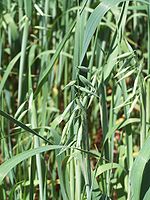
Photo from wikipedia
This paper describes the influence of Ascophyllum nodosum algae on the seeds, microgreens, yield, and yield components of oat Avena sativa cv. Bingo. This article includes the results from three… Click to show full abstract
This paper describes the influence of Ascophyllum nodosum algae on the seeds, microgreens, yield, and yield components of oat Avena sativa cv. Bingo. This article includes the results from three experiments. In one of the experiments, the oat seeds were soaked in a solution of demineralized water with dried comminuted and homogenized algae. For the FT–Raman spectra measurements, a spectrometer with an Nd:YAG laser, with a germanium detector, was used. The results obtained show that an excessively low as well as an excessively high alga concentration did not have an influence on the change in oat composition. Other algae concentrations that were used in these experiments caused significant chemical changes in the oat seeds. For the FT–Raman data, separation of the control from all the oat grains treated with different algae concentrations was possible. The aim of the pot experiment was to determine the effect of the application of algae (in different doses) on the A. sativa green mass of young plants (microgreens). The certified oat seeds, after being soaked in a solution with algae, were planted in the ground. For the chemometric analysis of the oat samples, a Fourier-transform infrared (FTIR) spectrometer device was used. The data were recorded with a viewing diamond with an attenuated total reflection (ATR) crystal plate. The FTIR spectra showed that soaking in an algae suspension affected the germination, general metabolism, and chemical composition of the oats. The use of algae did not change the lipid content of the plant. The three-year field experiment was established by introducing two factors: A. nodosum application (A) and a pre-sowing stimulation with a low-frequency magnetic field (S). The influence of experimental factors on the oat yield and its structure (yield structure components and yield components) was investigated. The beneficial effect of algae on oat yield was demonstrated by improved parameters such as the number and weight of the grains; however, under field conditions, the pre-sowing magnetic field stimulation of seeds did not have a beneficial effect. Various weather conditions also had a great influence on the yield. This study also considered the role of A. nodosum as a biostimulant in plants, and this showed potential under less favorable conditions.
Journal Title: Agronomy
Year Published: 2021
Link to full text (if available)
Share on Social Media: Sign Up to like & get
recommendations!